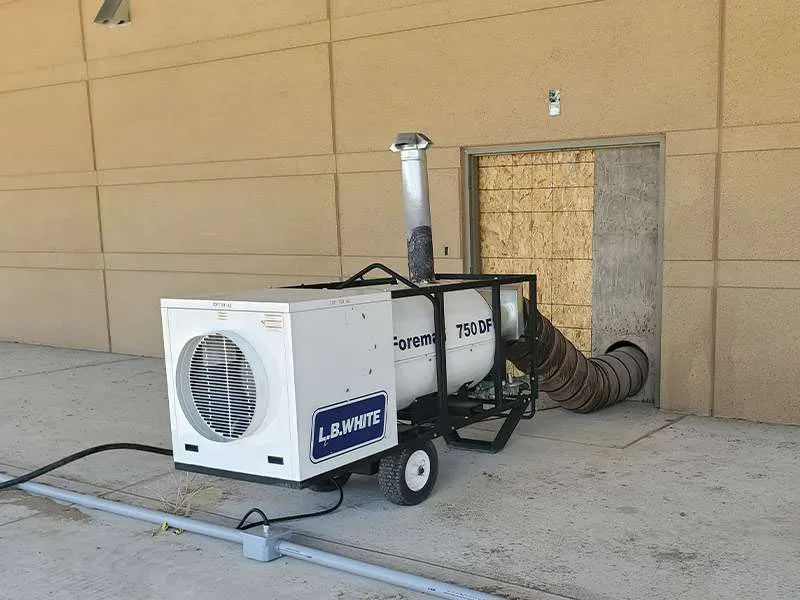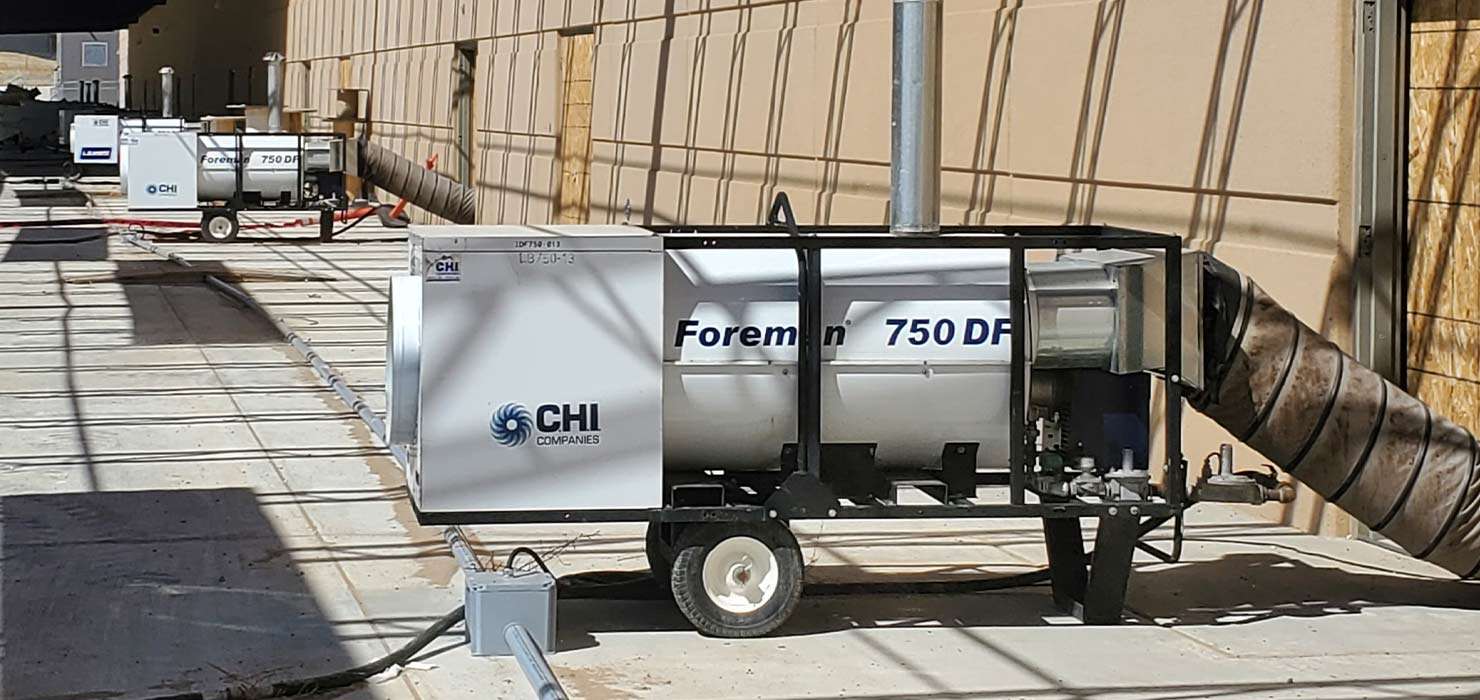Job site heaters are crucial for keeping construction projects on track during cold weather. This article explores the best options available and key factors to consider when choosing a heater for your construction site.
Key Takeaways
- Choosing the right job site heater involves considering factors such as fuel type, size, and site conditions to ensure productivity and safety.
- Propane heaters are portable, cost-effective, and reliable for job sites, while electric heaters offer efficiency and safety, particularly for indoor environments.
- Infrared heaters provide efficient, targeted heating and quick comfort restoration, which are ideal for fluctuating construction site conditions.
Choosing the Right Job Site Heater
Selecting the right heater is essential for maintaining productivity and safety. Factors like type, size, fuel source, safety features, and specific applications play significant roles in the selection process. Climate conditions in your work area can significantly influence your choice. Regions with extreme cold may require more robust heating solutions to keep workers comfortable and productive.
Budget constraints are another critical consideration. Construction heaters vary widely in price, influencing the decision between larger and smaller heaters. Balancing costs with heating needs is vital. Some models offer adjustable temperature settings, providing control over heat output for specific job site demands.
Construction heaters are versatile and suitable for heating workshops, thawing crawlspaces, drying basements, and general site heating. Experts can help select the most appropriate heater for your project and offer tailored recommendations to meet your heating needs.

Comparing Fuel Sources for Construction Heaters
The choice of fuel type significantly impacts a heater’s performance and cost. Common fuel sources include:
- Propane
- Kerosene
- Natural gas
- Electricity
Each fuel type has its advantages and challenges. For example, propane heaters are often more cost-effective than gasoline or diesel, particularly when bought in bulk. Propane can be stored on-site in large tanks, ensuring a steady supply and uninterrupted heating.
On the other hand, electric heaters offer better efficiency and ease of maintenance. They eliminate the need for fuel storage, simplify logistics and reduce fire or fume risks. However, they rely on a continuous power supply, which can be a disadvantage in areas prone to outages. Kerosene and natural gas heaters provide powerful heating but have higher operational costs and more complex maintenance.
Budget is a critical factor when choosing a fuel source. Propane heaters balance cost and efficiency, making them popular on many job sites. Electric heaters are ideal for indoor environments where safety and air quality are top priorities.
Ultimately, the best fuel source depends on your project needs and site conditions.
Types of Electric Construction Heaters
Electric construction heaters are becoming increasingly popular on job sites due to their efficiency and ease of use. They provide immediate warmth, and forced-air heaters are perfect for quickly warming large areas, making them ideal for expansive job sites.
Another type of electric heater, infrared heaters, offers targeted heat, making them highly energy-efficient and cost-effective. These heaters emit infrared waves that directly warm objects and people rather than the air, ensuring warmth is distributed where it’s needed most. This method is beneficial in cold weather construction, where maintaining a comfortable and productive environment is crucial.
Electric heaters are also safer, as they don’t carry the risk of fire or fumes like propane heaters. They require minimal maintenance, making them convenient and reliable. Electric heaters offer versatile, effective solutions whether you need to heat a small workspace or a large site.
Benefits of Propane Heaters on Job Sites
Propane heaters are a popular choice on job sites for several reasons:
- Portability, allowing easy movement and positioning as needed.
- Flexibility to direct heat to specific areas, enhancing worker comfort and productivity.
- Lower initial cost than electric heaters makes them economical for many projects.
Another significant advantage of propane heaters is their cost-effectiveness. Propane is typically less expensive than electricity, especially when purchased in bulk, leading to substantial savings over long-term projects. Propane heaters also have a longer lifespan, averaging around 20 years, compared to 12 years for electric heat pumps.
Reliability is crucial on construction sites, and propane heaters excel in this area. They ensure a constant fuel supply with on-site storage, eliminating concerns about power outages. Propane is also a cleaner fuel, with minimal emissions, making it an eco-friendly choice for environmentally conscious projects. These benefits make propane heaters a versatile and dependable solution for various job site heating needs.

The Role of Infrared Heaters in Construction
Infrared heaters play a unique and crucial role in construction settings. Unlike traditional heaters that warm the air, infrared heaters emit radiant heat that directly warms objects and people. This method is particularly efficient in outdoor construction environments, where conventional heaters struggle against wind. By warming surfaces instead of just the air, infrared heaters ensure warmth remains where needed, even in challenging conditions.
These heaters are especially effective in buildings with high ceilings, as they provide direct heat to floors and objects, leading to significant fuel savings. They can be mounted on ceilings or walls, saving valuable ground space on crowded construction sites. This setup optimizes space while ensuring heat is distributed evenly and efficiently.
Beyond efficiency, infrared heaters are known for their rapid heating capabilities. They quickly create a comfortable environment, avoiding delays common with traditional convection systems. This fast response is particularly beneficial in spaces with frequent door openings, as radiant heating can quickly restore warmth.
These features make infrared heaters a practical and efficient choice for maintaining a comfortable and productive work environment on construction sites.
Ensuring Safety with Job Site Heaters
Safety is critical when using heaters on construction sites. Propane heating systems are known for their stringent safety protocols, which contribute to their strong safety record and reliability. To prevent accidents, all temporary heaters should include safety features such as automatic shutoff and high-temperature protection.
Indirect-fired heaters, which contain the flame within a burn chamber, are typically safer as they reduce the risk of carbon monoxide exposure. Direct-fired heaters, with an open flame, should not be used inside wood-frame structures due to increased fire risk. Regular inspections and maintenance by qualified personnel ensure the safe operation of heating units.
Training on the proper use of propane heaters ensures teams use them safely and effectively. Following safety protocols and regular equipment maintenance reduces risks, providing a safe and productive working environment.
Portable Heaters for Flexible Heating Solutions
Portable heaters offer unparalleled flexibility on construction sites. Designed for easy transportation, they can be quickly set up in various locations. Many models include wheels and handles, making them easy to move as needed. This portability allows targeted heating where it’s most needed.
Portable heaters are versatile, suitable for indoor and outdoor use, and adaptable to different job site conditions. They are perfect for temporary setups and can be easily stored when not in use.
Available in different types, including forced-air and infrared heaters, portable heaters quickly and efficiently provide warmth, making them ideal for fast and flexible heating solutions.
Maintaining Productivity in Cold Weather Construction
Maintaining productivity during cold weather construction is challenging but can be addressed with the right heating solutions. Reliable heaters keep workers comfortable and focused. Studies show that warm working conditions improve concentration and reduce errors. Proper heating can prevent cold-related delays and enhance overall productivity.
Cold weather can hinder progress and lower morale. Heaters like propane and infrared models provide consistent, controllable heat, which is essential for tasks like concrete curing and drying. They can quickly restore warmth and conserve energy with short operational periods after cooling.
Heaters with higher outputs are necessary in extreme cold to maintain comfort and productivity. Construction heaters help keep projects on schedule by providing a warm work environment.
Selecting Larger vs. Smaller Heaters
Choosing between larger and smaller heaters depends on the area’s size. Smaller units are ideal for confined spaces, providing targeted heat without wasting energy. Larger heaters are better for extensive areas, delivering consistent warmth across a broader space. Matching heater size to the area avoids energy waste and ensures optimal comfort.
An oversized heater can cause temperature swings, leading to unnecessary energy consumption, while an undersized heater may overwork and become inefficient. Calculating the required heater size involves determining the necessary watts per square foot for the desired comfort temperature.
Selecting the right size ensures efficient heating, conserves energy, and maintains a comfortable working environment.
Contact Us for Expert Advice on Job Site Heaters
Choosing the best heater for your job site can be challenging, but personalized assistance simplifies the process. At Construction Heaters Inc. (CHI), we provide expert advice to help you select the right construction heater for your specific requirements. Our team offers tailored recommendations to ensure you get the most effective and efficient heating solution.
We supply and rent construction heaters, with same-day shipping available on most climate control products. Contact us for personalized recommendations and expert guidance on selecting the best job site heater for your unique needs.
Summary
Choosing the right job site heater involves considering various factors, including heater type, size, fuel source, and safety features. Comparing different fuel sources helps determine the most cost-effective and efficient option. Electric, propane, and infrared heaters each offer unique benefits that enhance productivity and comfort on construction sites.
By understanding the advantages and applications of different heaters, you can make informed decisions to keep your job site warm, safe, and productive. Whether you need a portable heater for flexibility or a robust propane heater for cost-effective warmth, the right choice can make a significant difference during cold-weather construction.
Frequently Asked Questions
What factors should I consider when choosing a job site heater?
Key factors include heater type, size, fuel source, safety features, climate conditions, and budget. Aligning these with your specific needs ensures optimal performance and safety.
How do propane heaters compare to electric heaters in terms of cost?
Propane heaters are typically more cost-effective than electric heaters regarding fuel consumption and initial investment. They also tend to have a longer lifespan.
What are the benefits of using infrared heaters on construction sites?
Infrared heaters deliver targeted heat directly to objects and people, providing efficient warming in outdoor and high-ceiling areas, which helps maintain productivity and comfort in cold conditions.
How do portable heaters enhance flexibility on a job site?
Portable heaters offer flexibility with easy transportation and setup, allowing targeted heating in various locations. This adaptability improves work efficiency and comfort for crews.
Why is it important to match the heater size to the area needing heat?
Matching heater size to the area ensures efficient heating, prevents energy waste, and maintains comfort, avoiding issues related to insufficient or excessive heat.
